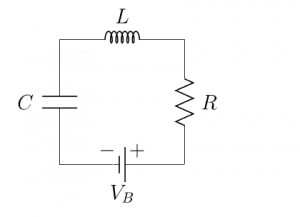3.2 Mathematical model
Course subject(s)
3. Extending the model
For a base clock for a computer, we want to build an LC-oscillator that generates 100MHz oscillations.

The components that are given are:
- a 5V battery: VB=5V,
- an inductor: L=0.004μH,
- the resistance: R=0.1Ω.
Our problem is
Find the capacitance C of the capacitor ([C]= henry) such that the current in the electrical circuit oscillates with a frequency of 100 MHz.
The following physical laws relate the current I(t) running in the circuit (measured in ampere), the charge on (one side of) the capacitor Q(t) (in coulomb) and the voltage drops over the different elements (in volts).
The current, I(t), is related to the charge on the capacitor, Q(t), according to I(t)=dQ/dt.
The voltage drop over the capacitor, V(t), is related to the charge on the capacitor by: V(t)=Q(t)/C.
The voltage drop over the inductor, VL(t), is related to the change in the current: VL(t)=L(dI/dt).
And an expression for voltage drop over the resistor, VR(t) is given by: VR(t)=RI(t).
Kirchhoff’s voltage law states that the voltage drop around a loop in a circuit equals zero: V+VL+VR−VB=0.
There are different options for a set of dependent variables to calculate in. We choose to calculate in current I(t) and the voltage drop over the capacitor V(t).

Mathematical Modeling Basics by TU Delft OpenCourseWare is licensed under a Creative Commons Attribution-NonCommercial-ShareAlike 4.0 International License.
Based on a work at https://online-learning.tudelft.nl/courses/mathematical-modeling-basics/.



